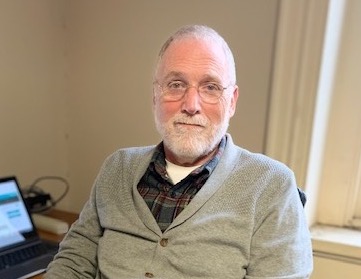All of our core programs at Baltimore Heritage rely on volunteers to plan them, organize them, and run them. We’d like you to meet some of these great people, and so we’re starting a series called Volunteer Spotlight to share a little about those who are helping us make a difference.
Our first Volunteer Spotlight features Richard Messick, who has been volunteering with Baltimore Heritage since 2014. When he began working with us, he was first tasked with captioning photos and editing articles for our website. Then Baltimore Heritage received a grant for the Legacy Business Program, and Richard jumped in. To date, he has identified, researched, and written articles on 10 Legacy Businesses that have operated in the city for a century or more. Richard also fabulously leads our tour, Catacombs, 100-Year Vendors and History at Lexington Market, and is a volunteer docent at Evergreen House.
In addition to our gratitude for all of Richard’s work, here’s what one happy tour participant recently said after taking Baltimore Heritage’s tour at Evergreen: “I recently took a friend to the Xmas tour of Evergreen. It was a first experience for both of us and one not to be missed by anyone interested in art, architecture or design. Our guide, Richard Messick, was excellent and knew the house backwards and forwards.”
Read the below Q&A session to get to know a little more about Richard.
Q: How did you get involved with Baltimore Heritage?
A: I grew up with Andrew Colletta, a Baltimore Heritage board member, and we cut our tour-guide-teeth exploring Baltimore together. We would take visiting friends on our “Funky Balmer Tour,” a circuit of hidden gems around the city that always ended with a deli stop. Andrew first told me about Baltimore Heritage.
In fact, Andrew and I became friends because of our mutual love of exploring. Baltimore is our home town. I was born in Baltimore, at the old St. Joseph’s Hospital when it was at Caroline and Oliver Streets.
Q: How long have you lived in Baltimore?
A: Besides an 11 year hiatus elsewhere, I have spent my whole life in Baltimore. Both parents were born and raised here.
Q: Where would you recommend new Baltimoreans go to learn about the city?
A: Highlandtown would probably be my first stop because its where so many ethnic mixes got their start. It’s still a wonderful mix of ethnicities and still a place to enjoy a variety of foods and meet different people. Food is the start in terms of getting to know another culture.
Q: Favorite Baltimore Heritage tour?
Q: What’s your favorite place in Baltimore? Why?
A: The Basilica because the architecture is sublime.
Q: Favorite hidden gem?
A: Evergreen [House]. It has a rich history and is filled with art—Asian ceramics; Japanese netsuke; 20th century paintings, sculpture, and art glass.
Q: What about Baltimore doesn’t get enough attention?
A: The legacy of slavery in Baltimore. Since I have delved into it, I have been amazed at what I don’t know. I have never considered the enormous market for enslaved people in Baltimore and Maryland during the 19th century. The marketing of people was very large here at that time. The change from raising tobacco to wheat in the region caused a surplus of labor, whereas the South needed more labor due to the invention of the cotton gin. Our country was built with cheap labor–indentured servants, slaves, and prisoners. We don’t give that enough attention.
Q: In one word, describe Baltimore:
A: Worn–like comfortable old clothes. The people and places are comfortable old clothes to me. My aforementioned life-long friend thinks Baltimore suffers from an inferiority complex, which may be true. We just need to put on our Sunday best a little more often just to remind ourselves of our rich, long and diverse history.

